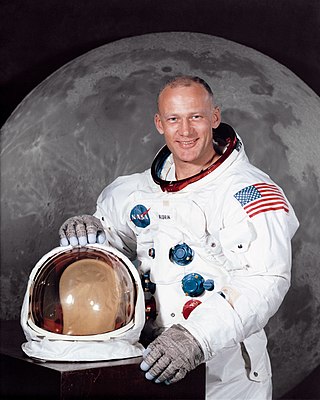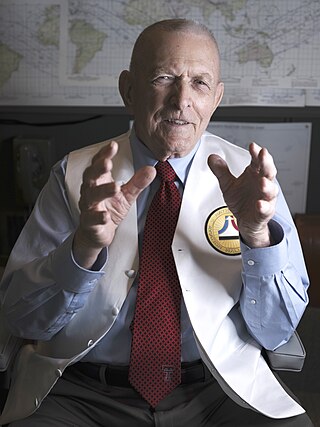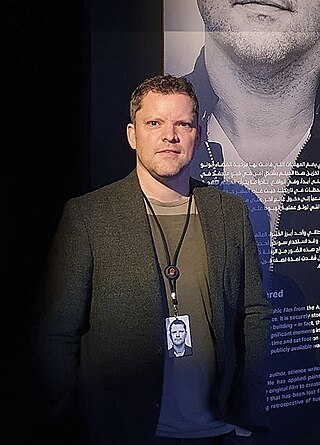Related Research Articles

Space exploration is the use of astronomy and space technology to explore outer space. While the exploration of space is currently carried out mainly by astronomers with telescopes, its physical exploration is conducted both by uncrewed robotic space probes and human spaceflight. Space exploration, like its classical form astronomy, is one of the main sources for space science.

Buzz Aldrin is an American former astronaut, engineer and fighter pilot. He made three spacewalks as pilot of the 1966 Gemini 12 mission. He was the Lunar Module Eagle pilot on the 1969 Apollo 11 mission and became the second person to walk on the Moon after mission commander Neil Armstrong.

Moon landing conspiracy theories claim that some or all elements of the Apollo program and the associated Moon landings were hoaxes staged by NASA, possibly with the aid of other organizations. The most notable claim of these conspiracy theories is that the six crewed landings (1969–1972) were faked and that twelve Apollo astronauts did not actually land on the Moon. Various groups and individuals have made claims since the mid-1970s that NASA and others knowingly misled the public into believing the landings happened, by manufacturing, tampering with, or destroying evidence including photos, telemetry tapes, radio and TV transmissions, and Moon rock samples.

Alan LaVern Bean was an American naval officer and aviator, aeronautical engineer, test pilot, NASA astronaut and painter. He was selected to become an astronaut by NASA in 1963 as part of Astronaut Group 3, and was the fourth person to walk on the Moon.

Eugene Andrew Cernan was an American astronaut, naval aviator, electrical engineer, aeronautical engineer, and fighter pilot. During the Apollo 17 mission, Cernan became the eleventh human being to walk on the Moon. As he re-entered the Apollo Lunar Module after Harrison Schmitt on their third and final lunar excursion, he remains the most recent person to walk on the Moon.

Charles Moss Duke Jr. is an American former astronaut, United States Air Force (USAF) officer and test pilot. As Lunar Module pilot of Apollo 16 in 1972, he became the 10th and youngest person to walk on the Moon, at age 36 years and 201 days.

Eugene Francis Kranz is an American aerospace engineer who served as NASA's second Chief Flight Director, directing missions of the Mercury, Gemini and Apollo programs, including the first lunar landing mission, Apollo 11. He directed the successful efforts by the Mission Control team to save the crew of Apollo 13, and was portrayed in the 1995 film of the same name by actor Ed Harris. He characteristically wore a close-cut flattop hairstyle and the dapper "mission" vests (waistcoats) of different styles and materials made by his wife, Marta Kranz, for his Flight Director missions.

Space Odyssey: Voyage to the Planets, marketed as Voyage to the Planets and Beyond in the United States, is a 2004 two-part fictional documentary created by Impossible Pictures and produced by BBC Worldwide, Discovery Communications and ProSieben. Space Odyssey chronicles a fictional crewed voyage throughout the Solar System, which is used to convey scientific information on spaceflight and on the different planets. The programme was initially announced under the title Walking with Spacemen as an instalment in the Walking with... franchise of documentaries. Though the title was changed before release and its connection to the other Walking with... programmes was removed, it was broadcast under the original title in Canada. The special effects and scientific accuracy of Space Odyssey was praised by critics, though some criticism was leveled at the storylines and drama portions of the programme.

Albert Roach Hibbs was an American mathematician and physicist affiliated with the Jet Propulsion Laboratory (JPL). He was known as "The Voice of JPL" due to his gift for explaining advanced science in simple terms. He helped establish JPL's Space Science Division in 1960 and later served as its first chief. He was the systems designer for Explorer 1, the USA's first satellite, and helped establish the framework for exploration of the Solar System through the 1960s. Hibbs qualified as an astronaut in 1967 and was slated to be a crew member of Apollo 25, but he ultimately did not go to the Moon due to the Apollo program ending after the Apollo 17 mission in 1972.

Apollo 11 was the first human spaceflight to land on the Moon. The 1969 mission's wide effect on popular culture has resulted in numerous portrayals of Apollo 11 and its crew, Neil Armstrong, Buzz Aldrin, and Michael Collins.
The notion that the Apollo Moon landings were hoaxes perpetrated by NASA and other agencies has appeared many times in popular culture. Not all references to Moon landing conspiracy theories are in support of them, but the ideas expressed in them have become a popular meme to reference, both in humor and sincerity.

When We Left Earth: The NASA Missions is a 2008 Discovery Channel HD documentary miniseries consisting of six episodes documenting American human spaceflight from the first Mercury flights and the Gemini program, to the Apollo program and its Moon missions and landings, to the Space Shuttle missions and the construction of the International Space Station.

The National Aeronautics and Space Administration is an independent agency of the U.S. federal government responsible for the civil space program, aeronautics research, and space research. Established in 1958, NASA succeeded the National Advisory Committee for Aeronautics (NACA) to give the U.S. space development effort a distinctly civilian orientation, emphasizing peaceful applications in space science. NASA has since led most American space exploration, including Project Mercury, Project Gemini, the 1968–1972 Apollo Moon landing missions, the Skylab space station, and the Space Shuttle. NASA currently supports the International Space Station and oversees the development of the Orion spacecraft and the Space Launch System for the crewed lunar Artemis program, the Commercial Crew spacecraft, and the planned Lunar Gateway space station.
Hubble Live, fully titled Hubble Live: The Final Mission, was a one-hour live American television special presentation that premiered on May 11, 2009 on the Science Channel. The program covered the launch of Space Shuttle Atlantis on NASA's Servicing Mission 4 (HST-SM4), the eleven-day fifth and final mission to repair the Hubble Space Telescope. The program was hosted by Josh Zepps, who is the host of science news series Brink, and featured interviews with NASA astrophysicist and space telescope expert Kim Weaver and former NASA astronaut Paul William Richards.
Rocket Science is a miniseries first released in 2002-2003, chronicling the major events in the American-Soviet space race, starting from the first hypersonic rocket planes through the development of human space flight, culminating with the mission by mission history of Projects Mercury, Gemini and Apollo. The series features interviews with X-1 and X-15 pilots Chuck Yeager, Scott Crossfield and Pete Knight, astronauts Gordon Cooper, Wally Schirra, Scott Carpenter, Gene Cernan, Frank Borman, James Lovell, Buzz Aldrin and Alan Bean, flight controllers Gene Kranz, Christopher Kraft, John Hodge and Sy Liebergot, engineers Günter Wendt, Max Faget, John Houbolt, Bob Gore, Robert Sieck and Richard Dunne, authors Arthur C. Clarke, Andrew Chaikin, Robert Godwin, Spider Robinson and Robert J. Sawyer, historians Paul Fjeld and Professor John Lienhart, Dr Raymond Puffer and Dr James Young, Manhattan Project physicist Hans Bethe, head of the Lovelace Clinic Dr. Donald E. Kilgore, Dr David Simons of Holloman AFB, Colonel Joe Kittinger, and broadcaster Walter Cronkite, among others. While focusing mainly on the American side of the race, the series also covered major Soviet achievements through every key phase of the 1950s and 1960s Space Race.

Jack Clemons is an aerospace engineer and air and space industry professional. He was a lead engineer on NASA's Apollo and Space Shuttle Programs, and later an aerospace company executive. He appeared as himself in the "Command Module" episode of the 2008 Discovery Science Channel six-part documentary Moon Machines. He also appeared as himself in the 2019 National Geographic Channel documentary Apollo: Back To The Moon. Following retirement from the aerospace industry, Clemons was a consultant and a professional writer as well as a speaker and presenter on NASA's space programs.

Discovery Science is an Indian pay television network, operated by Warner Bros. Discovery India, It primarily features programming in the fields of space, technology and science. The channel is a science television channel It was launched in 2010. From 1 March 2021, it began to follow a timeshifted schedule of the Southeast Asia feed.

Apollo 11 was the first human spaceflight to land on the Moon. In the decades after its 1969 mission took place, widespread celebrations have been held to celebrate its anniversaries.

Andy Saunders is a British film restorer and author who specialises in historical NASA imagery. He created the only clear image of Neil Armstrong on the moon and for his book, Apollo Remastered.
References
- ↑ Voyager's Final Message - Crowd sourcing one world to reach another, Response Source.
- ↑ The ultimate journey of human exploration comes to BBC ONE this November, BBC Press Office.
- ↑ – Return to Mission Leonid, BBC News
- ↑ – In the Leonids' lair, BBC News
- ↑ – Save the Moon!, BBC Sounds
- ↑ – For All Mankind, BBC Sounds
- ↑ – Christopher Riley III, IMDB
- ↑ – Christopher Riley III, IMDB
- ↑ – The moon shoot: film of Apollo mission on show again after 35 years in the can, Guardian
- ↑ "One small word for [a] man - one giant hoo ha for mankind!". Archived from the original on 19 January 2013. Retrieved 22 July 2009. – An analysis of the recording of Armstrong's statement on stepping on the Moon in July 1969
- ↑ – Armstrong's 'poetic' slip on Moon, BBC News
- ↑ – Movie recreates Gagarin's spaceflight, BBC News
- ↑ – Neil Armstrong: First Man on the Moon (2012 TV Movie) Full Cast & Crew, IMDB
- ↑ – The Fantastic Mr Feynman, BBC TWO
- ↑ – Joan Feynman: From auroras to anthropology
- ↑ – The Girl Who Talked to Dolphins - review
- ↑ – BAFTA Awards database
- ↑ – Realscreen
- ↑ – ANNOUNCING THE WINNERS OF GRIERSON 2015: The 43rd British Documentary Awards
- ↑ – National Geographic Channels announces film director Christopher Riley for Hubble
- ↑ - National Geographic Channel and NASA to Celebrate the 25th Anniversary of the Hubble Space Telescope at the World Premiere of NGC's Hubble's Cosmic Journey
- ↑ - Emmy Award Nominations 2015 full list
- ↑ - 59th BFI London Film Festival Announces Juries for First Feature Competition, Documentary Competition and Short Film Award
- ↑ - The Fear of 13 - the film producer's unbreakable promise
- ↑ - The Hollywood News - The Fear of 13 review: "A gripping documentary feature"
- ↑ "The Fear of 13". Rotten Tomatoes. Retrieved 16 January 2016.
- ↑ – The Fear of 13 - The Film Producer's Unbreakable Promise, Response Source
- ↑ "How two astronauts helped shoot Darren Aronofsky's new TV series from space". The Verge. 26 March 2018. Retrieved 26 March 2018.
- ↑ - Variety - Will Smith Nat Geo event series One Strange Rock.
- ↑ - 'Lightroom - The Moonwalkers: A Journey With Tom Hanks'.
- ↑ - Time Out 'Tom Hanks is narrating a spectacular space-themed immersive experience in London'.
- ↑ - Evening Standard 'Apollo Missions experience opening in London in December'.
- ↑ - 'The Moonwalkers: A Journey with Tom Hanks, Lightroom review - a thrill ride into the wonder of space'.
- ↑ - 'The Moonwalkers'.
- ↑ – 2014 BAFTA Nominations - SIngle Documentary
- ↑ "Nominations for Programme Awards 2013/2014 | Royal Television Society". Archived from the original on 26 February 2015. Retrieved 25 February 2015. – 2013-14 RTS Nominations for Programme Awards 2013/2014
- ↑ "The Grierson Trust - Nominations". Archived from the original on 4 December 2015. Retrieved 5 December 2015. - The Grierson Awards 2015
- ↑ - Emmy Award Nominations 2015 full list
- ↑ – CILIP Kate Greenaway Nominations 2020
- ↑ "Winners Gallery - Drain the Oceans - Battle for the Black Swan". 27 April 2022. Retrieved 27 April 2022.
- ↑ "BAFTA Scotland Awards 2022: Full Nominations List". 12 October 2022. Retrieved 12 October 2022.
- ↑ Archived 1 December 2009 at the Wayback Machine – Apollo raw and uncut, London Science Museum
- ↑ "Intermissions: Films from a heroic future" . Retrieved 21 November 2009. – Secrets of Apollo, Canadian Centre for Architecture.
- ↑ "Frequency 2013 | Chris Riley". Archived from the original on 2 November 2013. Retrieved 20 October 2013. – Frequency Artists 2013.
- ↑ Archived 2 May 2014 at the Wayback Machine – Apollo+40, super/collider
- ↑ "Apollo 50: Go for the Moon". The Air and Space Museum. Retrieved 12 July 2019.
- ↑ "Apollo 50: Go for the Moon Behind the scenes". The Air and Space Museum. Archived from the original on 13 December 2021. Retrieved 25 July 2019.
- ↑ "Digital Planet: Comparing the landscape of Mars to Earth".
- ↑ "Astronomers Without Borders: Worlds Apart". YouTube . Archived from the original on 13 December 2021.
- ↑ "Worlds Apart: Medium". 13 February 2022.
- ↑ Riley, Christopher (13 February 2021). "From Mars to Earth". Medium. Retrieved 22 April 2022.